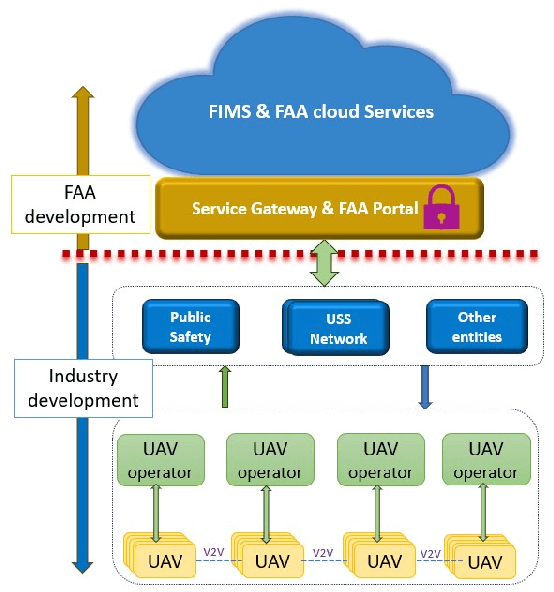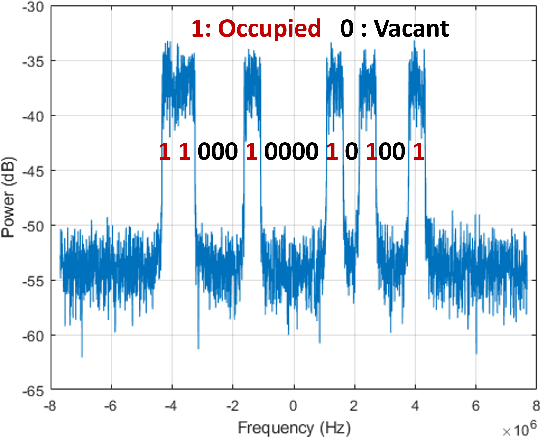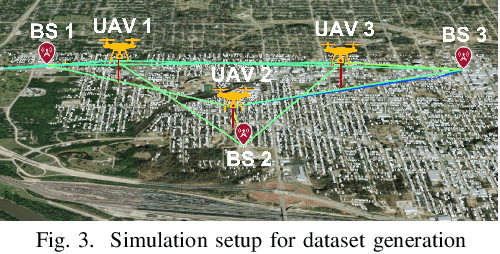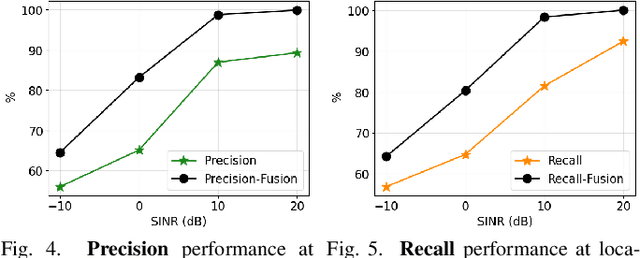Kenny Cheung
Federated Learning-based Collaborative Wideband Spectrum Sensing and Scheduling for UAVs in UTM Systems
Jun 03, 2024



Abstract:In this paper, we propose a data-driven framework for collaborative wideband spectrum sensing and scheduling for networked unmanned aerial vehicles (UAVs), which act as the secondary users (SUs) to opportunistically utilize detected "spectrum holes". Our overall framework consists of three main stages. Firstly, in the model training stage, we explore dataset generation in a multi-cell environment and training a machine learning (ML) model using the federated learning (FL) architecture. Unlike the existing studies on FL for wireless that presume datasets are readily available for training, we propose a novel architecture that directly integrates wireless dataset generation, which involves capturing I/Q samples from over-the-air signals in a multi-cell environment, into the FL training process. Secondly, in the collaborative spectrum inference stage, we propose a collaborative spectrum fusion strategy that is compatible with the unmanned aircraft system traffic management (UTM) ecosystem. Finally, in the spectrum scheduling stage, we leverage reinforcement learning (RL) solutions to dynamically allocate the detected spectrum holes to the secondary users. To evaluate the proposed methods, we establish a comprehensive simulation framework that generates a near-realistic synthetic dataset using MATLAB LTE toolbox by incorporating base-station~(BS) locations in a chosen area of interest, performing ray-tracing, and emulating the primary users channel usage in terms of I/Q samples. This evaluation methodology provides a flexible framework to generate large spectrum datasets that could be used for developing ML/AI-based spectrum management solutions for aerial devices.
Exploring the Interplay of Interference and Queues in Unlicensed Spectrum Bands for UAV Networks
Aug 09, 2023Abstract:In this paper, we present an analytical framework to explore the interplay of signal interference and transmission queue management, and their impacts on the performance of unmanned aerial vehicles (UAVs) when operating in the unlicensed spectrum bands. In particular, we develop a comprehensive framework to investigate the impact of other interference links on the UAV as it communicates with the ground users. To this end, we provide closed-form expressions for packet drop probabilities in the queue due to buffer overflow or large queuing delay, which are expressed in terms of a transmission policy as a function of the channel fading threshold $\beta$. The overall packet loss caused either by interference signals or queuing packet drop is obtained, which, in turn, yields in obtaining the expected throughput performance. Through extensive numerical results, we investigate the impact of the channel fading threshold $\beta$, which plays an important role in balancing the trade-offs between packet loss due to queue drop or transmission error due to large interference levels.
Collaborative Wideband Spectrum Sensing and Scheduling for Networked UAVs in UTM Systems
Aug 09, 2023



Abstract:In this paper, we propose a data-driven framework for collaborative wideband spectrum sensing and scheduling for networked unmanned aerial vehicles (UAVs), which act as the secondary users to opportunistically utilize detected spectrum holes. To this end, we propose a multi-class classification problem for wideband spectrum sensing to detect vacant spectrum spots based on collected I/Q samples. To enhance the accuracy of the spectrum sensing module, the outputs from the multi-class classification by each individual UAV are fused at a server in the unmanned aircraft system traffic management (UTM) ecosystem. In the spectrum scheduling phase, we leverage reinforcement learning (RL) solutions to dynamically allocate the detected spectrum holes to the secondary users (i.e., UAVs). To evaluate the proposed methods, we establish a comprehensive simulation framework that generates a near-realistic synthetic dataset using MATLAB LTE toolbox by incorporating base-station~(BS) locations in a chosen area of interest, performing ray-tracing, and emulating the primary users channel usage in terms of I/Q samples. This evaluation methodology provides a flexible framework to generate large spectrum datasets that could be used for developing ML/AI-based spectrum management solutions for aerial devices.
 Add to Chrome
Add to Chrome Add to Firefox
Add to Firefox Add to Edge
Add to Edge